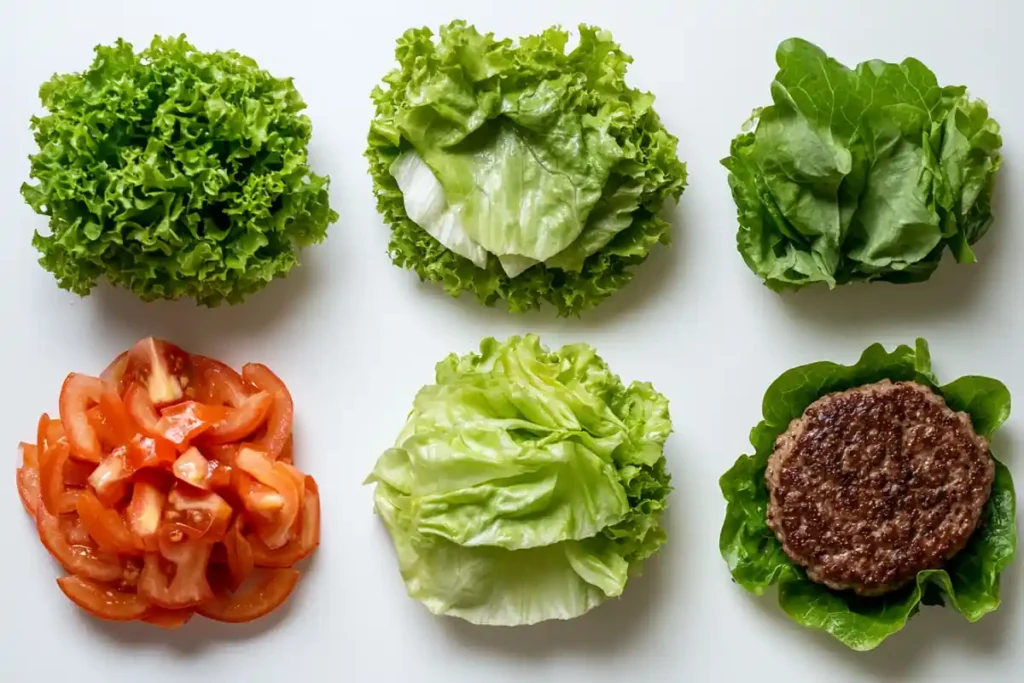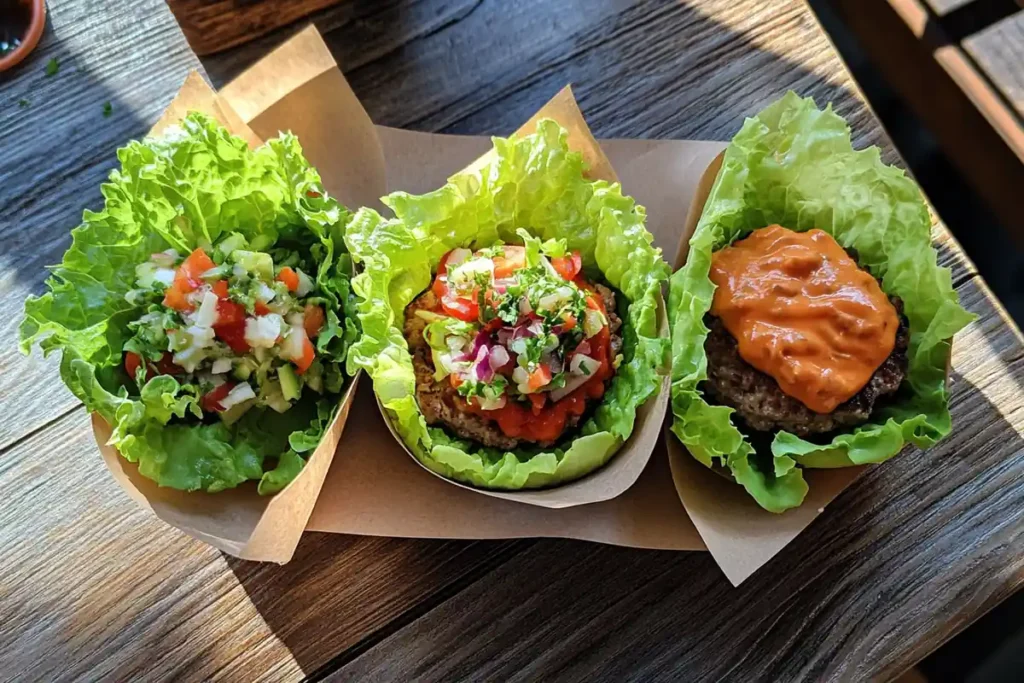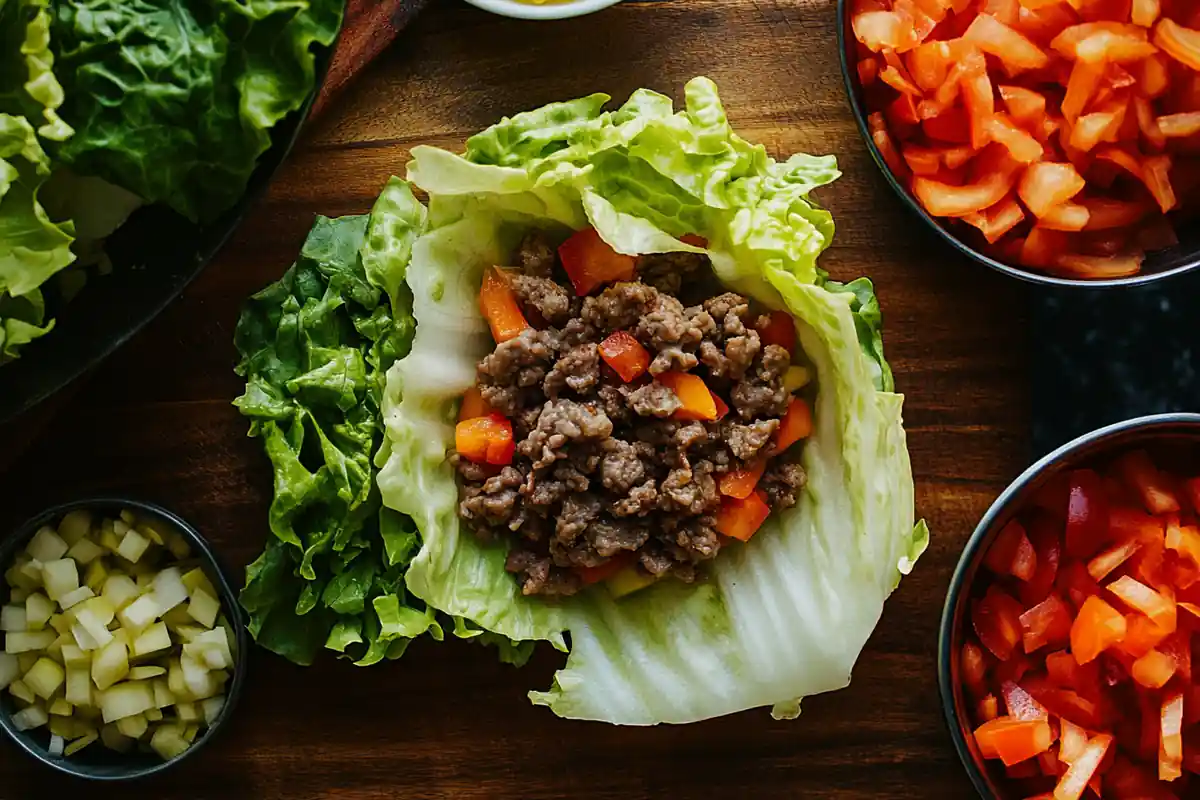Learn how to wrap a burger in a lettuce wrap perfectly. This guide covers step-by-step methods, best lettuce, and tips.
This comprehensive guide will teach you how to wrap a burger in a lettuce wrap. We will explore the best techniques for selecting lettuce, preparing ingredients, and assembling your lettuce wrap burger. Therefore, you will gain the skills necessary to create a delicious and manageable meal. This guide will provide a detailed breakdown of each step, along with tips for different types of lettuce. We will also look at common issues and how to avoid them. Ultimately, you will be able to create the perfect lettuce wrap burger every single time.
Table of contents
- Understanding the Basics of Lettuce Wraps
- Preparing Your Lettuce for Wrapping
- The Step-by-Step Guide to Wrapping
- Different Wrapping Techniques Explained
- Wrapping Based on Different Lettuce Types
- Portioning and Preventing Sogginess
- Common Mistakes and How to Avoid Them
- Conclusion: Mastering Lettuce Wrap Burgers
- Frequently Asked Questions
Understanding the Basics of Lettuce Wraps
Why Use Lettuce Instead of a Bun?
Using lettuce instead of a bun offers several advantages. This includes lower carbohydrate intake and a lighter meal. It also provides a refreshing and crisp texture, which complements a rich burger. Therefore, it is a popular choice for those seeking a healthier alternative. It also adds versatility, as it suits many dietary needs.
- Lower Carbohydrate: Lettuce is naturally low in carbohydrates, making it suitable for low-carb diets.
- Gluten-Free: It is naturally gluten-free, making it ideal for those with gluten sensitivities.
- Reduced Calories: Lettuce is low in calories. This reduces the overall calorie count of the meal.
- Added Nutrients: Lettuce provides vitamins and minerals, adding nutritional value to your meal.
- Refreshing Taste: The crisp texture and mild flavor of lettuce can enhance the eating experience.
Key Elements of a Good Lettuce Wrap Burger
A successful lettuce wrap burger includes the right ingredients and proper assembly. This ensures the wrap stays together and is enjoyable to eat. Therefore, every component plays a significant role in the overall outcome.
- High-Quality Lettuce: Choose the right type of lettuce. It must have the right size, texture, and strength for wrapping.
- Well-Cooked Patty: Cook your burger patty to your desired level of doneness. Ensure it’s well-seasoned.
- Flavorful Toppings: Select toppings that complement the burger and lettuce. This includes both vegetables and sauces.
- Secure Wrapping: Use a wrapping technique that holds everything in place. This will prevent a messy eating experience.
In the upcoming section, we will cover the steps for preparing your lettuce.
Preparing Your Lettuce for Wrapping
Selecting the Best Lettuce Leaves
Choosing the right lettuce is the first step in how to wrap a burger in a lettuce wrap. The lettuce needs to be large enough to hold the patty and other ingredients. It also has to have the right texture and flavor.
- Size: Select leaves that are large enough. They should easily wrap around the burger patty.
- Shape: Choose leaves that have a bowl-like or slightly curved shape. This will aid in wrapping.
- Texture: Select leaves with a sturdy texture. They should be flexible but not too soft.
- Freshness: Choose fresh lettuce leaves. They should be crisp and vibrant.
Washing and Drying the Lettuce
Properly washing and drying the lettuce is very important. This step will ensure your wrap is clean and not soggy. Furthermore, it will allow you to have a better dining experience.
- Washing: Wash the lettuce leaves thoroughly under cold running water. Remove any dirt or debris.
- Drying: Gently dry the leaves with a salad spinner or a clean towel. Make sure they are as dry as possible.
- Trimming: Trim the base of the leaves to remove thick stems. This will make the leaves more pliable for wrapping.
Moving to the next part, we will discuss the specific steps for wrapping.
The Step-by-Step Guide to Wrapping

A step-by-step view of how to assemble a lettuce wrap burger.
Step 1: Creating the Base
The base of your wrap is crucial for creating a solid structure. The base needs to be stable. This will provide a foundation for the rest of your ingredients.
- Lay Out Lettuce: Place one or two large lettuce leaves on a clean plate or surface. Overlap the leaves slightly to create a wider base.
- Ensure Stability: Make sure the lettuce leaves are lying flat and are not folded under. This provides a stable platform.
- Prepare for Patty: You need to make sure there is an area where the burger patty can comfortably rest. This area needs to be flat and stable.
Step 2: Positioning the Burger Patty
The next step is placing the burger patty onto the lettuce. The placement must be in a way that the patty is secure and stable. Therefore, ensuring a balanced wrap.
- Place the Patty: Position the burger patty in the center of the lettuce base. Make sure it is balanced on the leaves.
- Check Alignment: Ensure the patty is aligned with the lettuce base. It needs to sit correctly. It should not be extending beyond the edges.
- Leave Space: Make sure there is enough room around the patty for the toppings. This also leaves space for folding the lettuce.
In the following segment, we’ll talk about adding the toppings.
Step 3: Adding Toppings and Sauces
Adding the toppings and sauces adds flavor to your lettuce wrap burger. It is also important to balance them correctly. Too many toppings can result in an overfilled wrap.
- Add Toppings Evenly: Spread your favorite toppings evenly over the burger patty. This includes things such as tomatoes, onions, cheese, pickles, and avocado.
- Drizzle Sauces: Lightly drizzle your preferred sauces over the toppings. Avoid over-saucing to prevent sogginess.
- Layer Ingredients: Layer the ingredients in a way that makes sense. For example, you might want to place the cheese directly on top of the patty, and add other toppings on top.
Step 4: Wrapping the Lettuce
The final step is to wrap the lettuce around the burger. This step will bring the entire lettuce wrap burger together. It will also make the meal ready to be enjoyed.
- Fold and Tuck: Carefully fold the sides of the lettuce leaves inward, tucking them as you go.
- Secure the Wrap: Keep folding the leaves around the burger, forming a secure wrap.
- Handle with Care: Handle the wrap with care. Ensure that it is well-put-together and ready to be served.
Transitioning to the subsequent portion, we’ll discuss specific techniques.
Different Wrapping Techniques Explained

Comparison of overlap, taco, and cup methods for lettuce wraps.
The Overlap Method
The overlap method is very straightforward. It provides good stability to the wrap. This method also gives a lot of versatility.
- How it’s Done: Use two or more lettuce leaves. Overlap the leaves to create a wider, more stable base.
- Pros: Provides extra strength. Great for holding heavier fillings. This is also a great option for those who love a lot of sauce.
- Cons: It can create a bulky wrap. However, this depends on how the leaves are layered.
The Taco Method
The taco method resembles a traditional taco. This is a familiar and easy method for wrapping your lettuce wrap burger.
- How it’s Done: Use one or two large lettuce leaves. Fold them around the burger and toppings, as if forming a taco.
- Pros: Easy to handle and eat. It also creates a comfortable “handheld” meal.
- Cons: It can be less secure. May not hold heavy fillings very well.
In the next phase, we will discuss the “cup” and “roll” methods.
The Cup Method
The cup method uses the natural curve of a lettuce leaf. This method forms a cup-like shape. It is a great option for lettuce types with curved leaves.
- How it’s Done: Use a large, bowl-shaped lettuce leaf. Place the burger and toppings inside it. Allow the lettuce to form a natural cup.
- Pros: Good for holding all the fillings and sauces. Visually appealing. This creates a dish that also looks beautiful.
- Cons: Limited support for heavy ingredients. Only certain lettuce varieties are suitable.
The Roll Method
The roll method involves rolling the lettuce around the burger. This is similar to a wrap. Therefore, it creates a secure, elongated form.
- How it’s Done: Use a large lettuce leaf. Place the burger and toppings along the center. Roll the lettuce around the fillings, similar to a burrito.
- Pros: Good for portability. Offers a very secure and contained wrap.
- Cons: Can be difficult to manage. Requires some practice to get it right.
Continuing in the following part, we will address lettuce types.
Wrapping Based on Different Lettuce Types
Wrapping with Butter Lettuce
Butter lettuce is soft and pliable. Therefore, it requires a delicate approach when wrapping. This will allow for a manageable and delicious lettuce wrap burger.
- Technique: Use the overlap method. Also be very careful not to overfill the wrap.
- Tips: Gently fold the leaves. Avoid over-handling to prevent tears. It is also important to use a light hand when adding sauces.
Wrapping with Romaine Lettuce
Romaine lettuce is very sturdy and crisp. This makes it very suitable for wrapping. It can also handle a variety of different toppings and sauces.
- Technique: Use the overlap or taco method. The strong leaves can handle heavy fillings.
- Tips: Trim the base of the leaves for easier wrapping. The full leaf can be used to create a natural curve around the burger.
Advancing to the next topic, we will cover some specific tips for iceberg and green lettuce.
Wrapping with Iceberg Lettuce
Iceberg lettuce can be used for wraps. However, it’s less flexible than other types. It also has a tendency to break more easily. Therefore, being gentle with it is key.
- Technique: Use the overlap method. It is important to layer multiple leaves to create a sturdy base. The “cup” method is also a good choice here.
- Tips: Use the larger, outer leaves. Be very gentle when wrapping to prevent the leaves from cracking.
Wrapping with Green Leaf Lettuce
Green leaf lettuce has a balance of flexibility and strength. This makes it a versatile choice for lettuce wraps. It is a good middle ground, as it’s both strong and pliable.
- Technique: Use the overlap or taco method. The leaves have a natural curve, which will aid in wrapping.
- Tips: Select medium-sized to large leaves. Avoid overfilling to maintain the wraps’ integrity. Also, take care when folding the edges inwards.
In the ensuing segment, we will talk about portioning and sogginess.
Portioning and Preventing Sogginess
The Importance of Portion Control
Portion control is crucial for a manageable lettuce wrap burger. Too much filling makes it difficult to eat. It will also compromise the structural integrity of the wrap.
- Patty Size: Use a burger patty that fits comfortably. It should not be too large. It has to fit within the confines of your lettuce leaves.
- Topping Quantity: Don’t overfill with toppings. The goal is to have a balanced wrap. This also allows room for the lettuce to wrap around the contents.
- Sauce Control: Apply sauces sparingly to prevent sogginess. Too much sauce will lead to a messy meal.
How to Avoid Sogginess
Preventing sogginess is essential for a good lettuce wrap burger. The wrap should stay fresh and crisp, not wilted and soggy. Therefore, proper steps are required to make sure this is the case.
- Dry Ingredients: Use dry toppings and ingredients whenever possible. Wet ingredients will introduce excess moisture.
- Lean Proteins: Leaner proteins tend to release less moisture. This also helps to prevent the lettuce from getting soggy.
- Sauce Placement: Apply sauces directly onto the patty. This minimizes direct contact with the lettuce.
- Eat Immediately: Assemble and eat your lettuce wrap burger right away. This prevents the lettuce from becoming soggy.
Common Mistakes and How to Avoid Them
Overfilling the Wrap
Overfilling is a common mistake. It leads to messy and difficult-to-handle lettuce wraps. Therefore, proper planning and portioning is key to avoiding it.
- Problem: Too many ingredients make the wrap unstable. This also causes it to break while you’re eating it.
- Solution: Be mindful of portion sizes. Only use a moderate amount of fillings. Avoid overloading the lettuce leaves.
Not Drying Lettuce Properly
Not drying the lettuce properly is another common error. This leads to soggy wraps. It also compromises the texture of your dish.
- Problem: Excess moisture causes the lettuce to become soggy and limp.
- Solution: Use a salad spinner or a clean towel to pat dry the leaves very well.
Using the Wrong Type of Lettuce
Using the wrong type of lettuce can lead to frustration. Different varieties offer different levels of stability and structural support.
- Problem: Some lettuce types are too soft, while others are too brittle.
- Solution: Choose sturdy lettuce. Romaine and butter lettuce are ideal.
Conclusion: Mastering Lettuce Wrap Burgers
In conclusion, understanding how to wrap a burger in a lettuce wrap will enable you to create delicious and healthy meals. Proper preparation, selecting the right lettuce, and mastering the wrapping techniques are all essential. By following the steps outlined in this guide, you’ll be able to enjoy a perfectly wrapped lettuce wrap burger. The key is to practice and adjust your techniques according to your preferences. Therefore, you will be able to create a restaurant-quality dish at home.
Frequently Asked Questions
To properly wrap a burger, prepare the lettuce, place the patty on the leaves, add toppings, and fold the lettuce around it, tucking as you go to form a secure wrap. Overlapping leaves provides added support.
Butter lettuce and romaine lettuce are the best for burger wraps. Butter lettuce is soft, while romaine is sturdy. Both offer great flavor. They are also suitable to hold many kinds of toppings.
No cutting is needed. Instead, trim the thick stem at the base of each leaf. This makes the leaf more flexible for wrapping. The rest of the leaf should be left whole. This is the ideal shape for wrapping.
Instead of putting lettuce on a burger, use it to wrap the burger. Place the burger patty on a large lettuce leaf, and then add toppings. Then, wrap the lettuce around it to create the wrap, effectively replacing the traditional bun.

